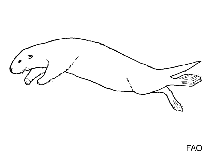Lutra lutra (Linnaeus, 1758)
Eurasian river otter| Native range | All suitable habitat | Point map | Year 2050 |

|
| This map was computer-generated and has not yet been reviewed. |
| Lutra lutra AquaMaps Data sources: GBIF OBIS |
Upload your photos
Google image | No image available for this species;
drawing shows typical species in Mustelidae.
Google image | No image available for this species;
drawing shows typical species in Mustelidae.
Classification / Names Common names | Synonyms | CoL | ITIS | WoRMS
Mammalia | Carnivora | Mustelidae
Environment: milieu / climate zone / depth range / distribution range Ecology
Pelagic; freshwater. Tropical
Distribution Countries | FAO areas | Ecosystems | Occurrences | Introductions
Asia and Europe Inland Waters, Northeast Atlantic; Indo-West Pacific, and the Mediterranean: Lutra lutra lutra: Ireland, Great Britain, Maghrib, continental Eurasia from Scandinavia and the Iberian Peninsula east to Kamchatka and Manchuria, Sakhalin, Kuril Island; Lutra lutra meridionalis: Turkey, southern Caucasus, Israel, Syria, Iraq, Iran; Lutra lutra seistanica: southern Turkmeniya, Iran, Uzbekistan, Afghanistan, and southern Kazakhstan, Xinjiang; Lutra lutra kutab: Pakistan, Tibet; Lutra lutra monticola: India, Nepal; Lutra lutra aurobrunnea: India, Nepal; Lutra lutra chinensis: China, Indochina, Thailand, Malaysia, Vietnam, Ryukyu, Taiwan; Lutra lutra nair: India, Sri Lanka; Lutra lutra hainana: Hainan, China; Lutra lutra whiteleyi: Hokkaido, Japan; Lutra lutra sumatrana: Southern Vietnam, peninsular Malaysia, Singapore, Indonesia (Ref. 1522).
Length at first maturity / Size / Weight / Age
Maturity: Lm ? range ? - ? cm Max length : 980 cm TL male/unsexed; (Ref. 1005); 1070 cm TL (female); max. published weight: 10.0 t (Ref. 1005)
Feeds on fish and benthic invertebrates (Ref. 8723). It is preyed upon by the Atlantic salmon (Ref. 32771).
Life cycle and mating behavior Maturity | Reproduction | Spawning | Eggs | Fecundity | Larvae
Main reference
References | Coordinator | Collaborators
Rice, D.W. 1998. (Ref. 1522)
IUCN Red List Status (Ref. 130435: Version 2024-1)
Near Threatened (NT) ; Date assessed: 31 January 2020
CITES status (Ref. 108899)
Appendix I: International trade banned
CMS (Ref. 116361)
Not Evaluated
Threat to humans
Human uses
| FishSource |
Tools
More information
Trophic Ecology
Ecology
Population dynamics
Growth
Age/Size
Length-weight
Length-length
Length-frequencies
Mass conversion
Recruitment
Abundance
Age/Size
Length-weight
Length-length
Length-frequencies
Mass conversion
Recruitment
Abundance
Life cycle
Reproduction
Maturity
Fecundity
Spawning
Eggs
Egg development
Larvae
Larval dynamics
Maturity
Fecundity
Spawning
Eggs
Egg development
Larvae
Larval dynamics
Distribution
Human Related
Aquaculture profile
Stamps, Coins Misc.
Stamps, Coins Misc.
Outreach
Taxonomy
References
Internet sources
BHL | BOLD Systems | CISTI | DiscoverLife | FAO(Publication : search) | Fishipedia | GenBank (genome, nucleotide) | GloBI | Gomexsi | Google Books | Google Scholar | Google | PubMed | Tree of Life | Wikipedia (Go, Search) | Zoological Record
Estimates based on models
Preferred temperature
(Ref. 115969): 6.7 - 14.9, mean 9.9 (based on 231 cells).
Price category
(Ref. 80766):
Unknown.



